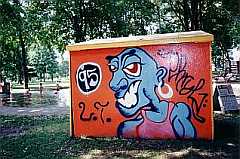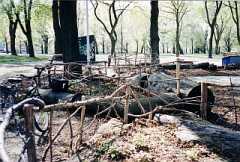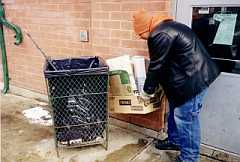
Comments?
For the basics, see
- Website & Privacy Policies
- How To Get Involved
- The Role of the Park
Search options:
Department Site Map

Custodians:
Vandalism, how we deal with it:
All parks are troubled by vandalism, and when we built our park outdoor ovens we had to get practical about dealing with it. The things that we found out about protecting the ovens will also work for other kinds of park vandalism. Here are the rules of vandalism that we go by.
Watch new structures more closely:
A new structure draws attention to itself for a month or so. After that it seems to fade into the background. Potential vandals lose interest. Our first outdoor oven had extensive shingle damage two days before the mayor came to inaugurate it. We had our ceremonies with plastic stapled to the roof. We should have been watching the park more during that first month, but we didn't know that then.
The playground shed

This image appeared on the back of
playground shed one morning. Although a
skilful cartoon, its nasty leer
seemed unsuited to the playground.
We hired some young kids to paint it
over with green park paint later that
same afternoon. We heard a rumour that
one of the wading pool staff, who was a
gang member in his spare time, had come
to the park after midnight the night before,
and painted the gangster image. He did it
one more time, and after that he didn't
bother. Too much trouble -- hours of work
and then it's gone the day after.
Repair vandalism (including graffiti) right away:
Vandalism damage is a song about power. While the damage is there, the song keeps playing: "we own this park, this is our turf, you should be worried about what we'll do next, you can't stop us because we're invisible." But that's not true. The message only works when the damage is on display. When shingles are replaced, gardens are replanted, fences are mended, graffiti is painted over right away, the power song stops playing. After two repairs to the same site, it's seldom necessary to do another repair soon. The vandals get bored.
Give the vandals a few very easy targets:
It's pretty easy to rip shingles off the outdoor oven roof, and also easy to repair them. We have to replace a few shingles about twice a year, so we keep a supply on hand. The reason the oven shingles are the main focus for vandals is that most vandals, thankfully, are quite lazy. Tearing shingles off the oven takes only a little effort. That's good, because it means the vandals can quickly accomplish their foolish aim and go away satisfied. The rest of the oven is brick and concrete, which is hard to chip and crack, and also harder to repair. Vandals will usually only do the more strenuous damage if there is nothing easy nearby for them to wreck. If we hadn't had shingles that were easy to rip off, we might have added them later, because they are such a good decoy for vandals.
Supply alternative targets:
On the same note, it's helpful to have a few picnic tables nearby so vandals can carve their initials (if they're energetic) or draw some obscene figures (if they brought their felt marker). That way they will be distracted from carving or marking up the oven, which is more difficult to fix. We scrub the obscene stuff off the tables and leave the initials. Some people need to leave their mark.
Let the oven (or any other important park structure) make friends for itself:
Our second oven is covered with barn board, much easier to damage. But there hasn't been any damage. By now, many youth have eaten the bread or the pizza, and many children have made pizza at the park with their class. It seems that these young people consider the oven as their partial possession, an important element in "their" park, which they say is the best park anywhere, better than the oven-less parks of their unlucky friends. Their gloating helps us more than any video surveillance. People want to protect what they're proud of. The same thing seems to be true of -- for instance -- the park's rink house/ clubhouse. When we added windows to the building, some folks were sure the windows would soon be smashed. But they were not. The building is too useful and popular with people who use the park -- including young folks who sometimes make trouble. The more trouble we take to make things work well and look nice, the less vandalism there seems to be. This rule doesn't give absolute protection (there are always foolish people who "don't get it") but it seems to apply most of the time.
Take vandals to court if they're caught:
Regrettably, our parks administration in Toronto doesn't have a practice of following cases of vandalism through court. If the police make an arrest in a park they don't always notifythe parks staff either; in fact they rarely do. The message is that trashing things in parks is not likely to bring much inconvenience to persons who are caught. This is not a good message.
If park staff, police, or the courts don't take vandalism seriously, community follow-up can help:
When a friend of the park caught a group of young guys trashing the playground one November night, these guys threatened to beat her up. But she went home and called the police. The police caught one of the vandals. In the process of trying to follow his case to court we spoke to judges, crown attorneys, defence lawyers, and probation officers, and we tried to make many people aware of the effects of vandalism and threatening behaviour in parks. Even though the charge was later mislaid by the police and therefore never went to court, we learned the young man's name, and all our court-visiting paid off. One day we got a call from the probation department saying that the same young man had been ordered by the court to perform 50 hours of community service for an unrelated charge (assaulting a police officer). He was willing to do the hours at our park. This meant we were able to talk to him directly and also he did some useful repair work for us (repairing damage done in the park by other people, whom we did not catch). This young man was unusual in that he, when drinking, did much more damage than vandals normally do (i.e. he didn't follow the "lazy vandal" rule). We found out that when he was sober, he was also able to do much more constructive work than court-ordered workers generally do. And he saw, when sober, how a good park works. Just as important, other youth in the park have seen that the park staff will follow through on vandalism. We get respect for that, and the ovens, the buildings, the benches, the gardens, and the playground structures get remarkably little damage.
They wrecked our
playground garden fence too...

...and then did
community work.




 Printer friendly version
Printer friendly version